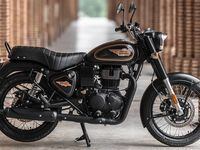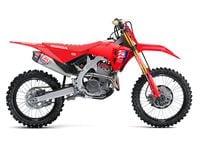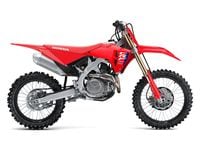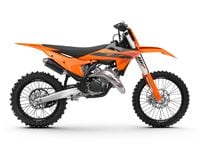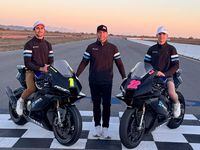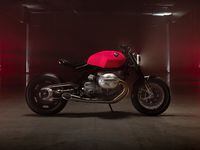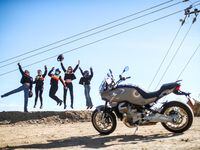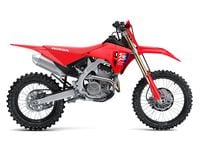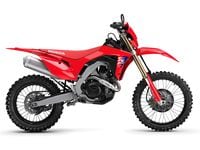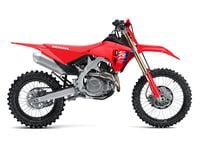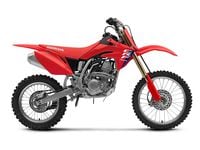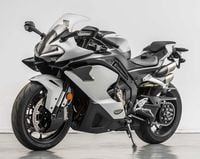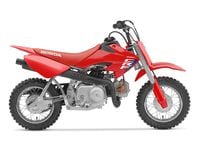American Flat Track (AFT) plans 2025 to be the beginning of a 100 percent production-based Twins class. No more race-only factory bikes like Indian’s FTR750, which has won the last eight Grand national Championships, or Harley’s “forever bike,” the classic XR-750.
AFT’s plan for next year will apparently control every non-original part that goes into the approved production engines. The appeal of a production-based series is the prospect of many brands in the close and exciting contests for which AFT dirt-track is justly famous.
In the teen years of this new century Harley-Davidson’s classic XR-750 dirt-tracker was showing its age: short big-end life, cam gears breaking. Veteran tuner Bill Werner’s Ninja 650-based project began to show real strength, so there was serious talk of alternatives. Might AFT switch to an all-production-based formula? Might Kawasaki “come in” with something new? Or Yamaha? Or KTM? Would Harley upgrade or replace the XR, which had come to so perfectly suit dirt itself? Harley built racers based on the 750 “Street,” or G-bike. Although no longer produced, it remains on AFT’s list of approved engines.
Then in 2016 something happened. Gary Gray of Indian talked with Reid Wilson, then Indian’s director of marketing. “The last [time] people remember us racing as a brand was in flat track. Bill Tuman was national champion on Indian in 1953, and since then Harleys won the GNC 50 times. So why don’t we go do this?”
Wilson agreed. Gray continued, “Yeah, we opened up the rule book and [purpose-built] race engines have been legal forever. And we looked at what we had for engines, which at the time was a big, very heavy 1200 cruiser engine. We know what it takes to take a production engine and turn it into a race engine. And we’re like, ‘It’s probably easier just to build what you need in the first place.’
“So yeah, we just followed the rule book. You were allowed a max of 750cc, you’re allowed a max throttle body of 38mm. We went rule by rule and said, ‘OK, how do we design an engine that fits these rules?’ "
A big company (Indian’s parent company Polaris grossed over $8 billion in 2022) wanting to bring a new racebike to flat track was a godsend for the flat-track series. Action at last!
Michael Lock (then director of American Flat Track) said, “Indian wanted to establish themselves versus Harley-Davidson in some kind of format. They were desperately keen but had nothing suitable in production. The rule book still allowed a race-only 750 engine.
“We were delighted. It was a way to reintroduce flat track as an all-American sport. We had an agreement with Indian.
“Indian said, ‘Look, this is a stopgap. Let us compete to 2019.’ No one then knew how dominant it would be.”
The decision came in January 2016, and by May, I went to Indian to see a prototype chassis with rapid-prototyped engine and bodywork, speaking by phone with FTR designer Urs Wenger, at Swissauto (an engineering firm acquired by Polaris).
The pace from there quickened:
June 4, 2016—In Switzerland I see the finished 106-pound engine, both apart on a large table and running on the dyno.
July 29, 2016—I see rider Jared Mees test the prototype machine at Charlotte, North Carolina’s half-mile bowl.
End of 2017—Indian’s FTR750 wins its first new-era Grand National Championship of eight in a row: six by Jared Mees, two by Briar Bauman.
How was this done? You begin by studying existing best practice. Harley’s aluminum XR had steadily evolved since 1972. You measure winning chassis, locate major masses, analyze swingarm squat/anti-squat geometry, measure stiffnesses. You dyno the best engines you can lay hands on, to understand not so much the power, but the torque curve.
Power was not the key. In their early eagerness to stir up the class, AFT had pretty much invited all comers, which included 120-hp KTMs. They did not turn out to be the “great equalizer” that would put everyone in the inner circle.
Testing results were fascinating. The XR’s torque curve began in the mid-to-high 5,000s and was a down-sloping straight line up to maybe 9,200 rpm or a bit more. What? Think about it: If torque falls as the engine revs up, it could act as natural anti-spin. The rear tire loses grip, the engine revs up and loses torque (at the rate of about 6 lb.-ft. per thousand revs), and so maybe re-grips and all is not lost. How much power? Someplace between 90 and 100 hp at the rear wheel.
For Honda’s five “upstart” GNCs (split between Bubba Shobert and Ricky Graham) the down-sloping straight-line torque was carefully matched, but a bit lower because the RS750 revved higher. When the RS began to win, the AMA imposed intake restrictors.
In Switzerland I was shown the torque just measured on the dyno run I’d witnessed: dead flat from 7,000 rpm to just shy of 11,000 rpm, where it began to fall. Dyno runs are strange because the test crew are nonchalant behind double glass, while the engine rages and roars, vibrating with the fury of combustion. Just what it’s designed to do.
As follows: The engine is a water-cooled 53-degree V-twin, intentionally made compact to allow maximum latitude of placement in the chassis. Any V less than 53 degrees and the piston skirts get too close around BDC. Urs Wenger said the bore was determined by the valve sizes needed to make 110 hp at 10,000 rpm, so it was given 88.0 x 61.5mm bore and stroke (the XR was 79.4 x 75.7mm). The FTR’s bore/stroke ratio of 1.43, if ranked by the evolution of this ratio in Superbike, puts the design in the early ‘90s. Don’t be fooled: The goal is to deliver usable, finely controllable flat torque. Gary Gray would later say that the FTR engine needed a program of dialing back to make the bike hook up.
Vibration is reduced by two primary balancers. The FTR is an all-plain-bearing design, with split-and-bolted con-rods on a single crankpin (the front cylinder links to the left rod). The engine is fuel injected, using stock “Scout” injectors. Target time before overhaul (TBO) was 30 hours.
Like the XR before it, the FTR has as short a wheelbase as possible (55.0 inches) with front and rear wheels crowded as close as possible to its engine, short of actual contact. Steering rake is 25 degrees plus or minus 2 degrees of adjustability, with 3.9 inches of trail. Stock fork offset is 53mm.
Base price? $49,900, discounted $5,000 for bona fide race teams (as opposed to collectors). Yes, that’s more expensive than the old XR-750 build kit in Bob Conway’s wooden crate. But to make a competitive bike from that crate, you need more than the service book. You need one of the top XR builders to assemble it properly, modifying nearly every part in the process.
Then there was keeping it running. Chris Carr told me that his factory XRs were given a fresh big-end assembly (bottom rod bearings) every national. That’s $1,800 in parts and labor: removing, rebuilding, and replacing the crankshaft.
FTRs arrived ready-to-race. Gas up, air up, and race. Here’s Gary Gray again, talking in 2021 about that tricky word, “production”:
My question: What does production mean? Just the H-D crankcase is stock?
Gary Gray: “Oh boy, yeah, I’ve heard rumors that even that is modified. I’ve heard rumors that everybody else is welding and machining their crankcases. At the top, the intake tract doesn’t have to be production. The throttle bodies don’t have to be production. The valves, valve springs, seats, cams don’t have to be production. The cylinders don’t have to be production—the pistons, the rings, the connecting rods, the crank. They can run external flywheels and we cannot. Clutches? Not production. Transmission? Not.
“If you look at most FIM or AMA regulations, [production means] for sale and readily available, which ours are. If you want to buy [an FTR] piston, a crankshaft, connecting rod—anything—you can readily buy it. We sell them to anybody who wants to buy, so by most racing bodies’ definition of what production is, ironically ours is the only production bike out there.
Another thing Michael Lock said was, “We’d rather make parity than kill the Indian.”
That course was tried for some time. Gary Gray noted, “We spent a fair amount of time developing the weighted flywheel (heavier for loose or slippery surfaces, lighter for higher grip). They took that away [mid-2021] and then added 20 pounds to [the motorcycle] midseason, and took 8 pounds off our rear wheel.”
In dirt track, anything that contributes rotational inertia to the driveline—notably the crank and rear wheel—tends to make tire hookup easier to achieve. Taking it away has the opposite effect. Like proper racers, the teams running Indians found ways to recover the lost hookup.
Some have proposed that the FTR be “productionized.” That would require making room for the usual six-speed gearbox (FTR needs only four ratios) and adding electric starting, a modern high-wattage alternator, a battery, and a raft of changes to hit the current mid-displacement price point. FTR was designed for the actual run of 100 bikes. Design for producing thousands is much different.
After the announcement that Indian’s FTR is out for next year, and that AFT is adopting a production-based twins formula for next year, CW Editor-in-Chief Mark Hoyer asked Gary Gray, “What’s next? Will you put something into production that’s eligible for the new class?”
He replied, “That’s like somebody shoots my dog, and you come asking, ‘What kind of dog are you going to get?’ "
In the fullness of time, we’ll see.

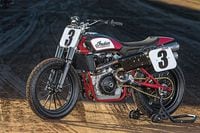
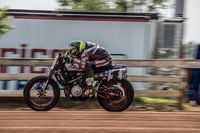
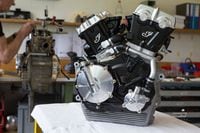
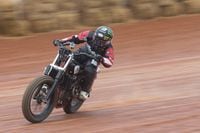
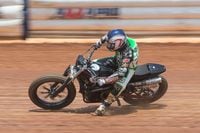
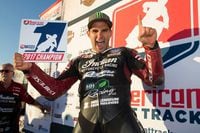
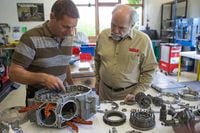

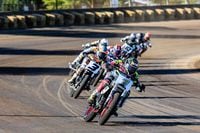
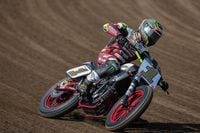
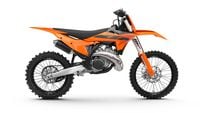
/cloudfront-us-east-1.images.arcpublishing.com/octane/N575KB7BDZDPPJBRLZRG2ANHKI.jpg)
/cloudfront-us-east-1.images.arcpublishing.com/octane/T77HXRXV4NGKDNZODMSEIBRXPE.jpg)
/cloudfront-us-east-1.images.arcpublishing.com/octane/NKMM7V2P3BCSXAV6J56FKK67OU.jpg)
/cloudfront-us-east-1.images.arcpublishing.com/octane/SWQRQV27DNFA7LXGFI7FNFNGOQ.jpg)
/cloudfront-us-east-1.images.arcpublishing.com/octane/GYEXUJBV5JGQLLZNXO7KRVSTEY.jpg)
/cloudfront-us-east-1.images.arcpublishing.com/octane/MCWUSJJVJVG45P7QQG3WOXZR54.jpg)
/cloudfront-us-east-1.images.arcpublishing.com/octane/AJ4EFPH2CRDURDAB5LPEA2V2NE.jpg)
/cloudfront-us-east-1.images.arcpublishing.com/octane/LSDHIL22SZAFFPYLKP5ZXLJSIY.jpg)
/cloudfront-us-east-1.images.arcpublishing.com/octane/SH46HIOX4RELXLXF6AE3SFGH4A.jpg)
/cloudfront-us-east-1.images.arcpublishing.com/octane/JUZ52WFWLJGMNH7PGZNOKP3MUY.jpg)
